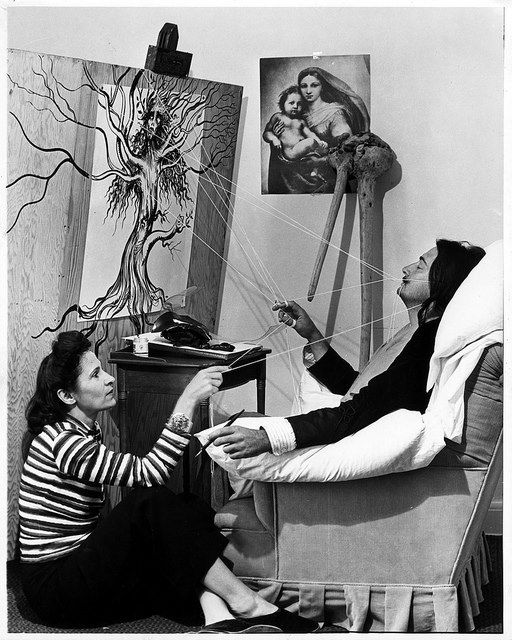
Performance art is a popular form of contemporary art that is growing in popularity. It is motivated by the desire to connect with the audience. American and Serbian art are both known for their exploration of the interaction between artist-performer. Marina Abramovic's Rhythm 0 (1992), where the artist invited people to place objects on the artist's body, is one of its most famous examples. Another piece saw her sitting silently at MoMA for 736 hours, allowing patrons to have a conversation with the artist.
Yves Klein's postmodernist art
Yves Klein (French artist) died in 1962. He graduated from Tokyo's Kodokan and was also a black belt of judo. He set out to find his identity in 1959's manifesto. He achieved an avant garde style marked by unexpected compositions and performance. Klein's avantgarde work was not only an inspiration for conceptual art but also institutional critique.
Saut dans le vide (Saut into the Void) is a photomontage showing a man leaping from a building. It is one of the most important works of postmodernist artwork. Klein, who later created performance art, was known as the pioneering conceptual artist of 20th century. His 1958 performance art exhibition The Void was a seminal achievement in performance arts. It featured a series invisible artworks displayed in a gallery.

Fluxus artists
Many of Fluxus' artists are still alive today. The art of many of them has been incorporated into contemporary artists' works. George Maciunas started the group in 1966. It continued to exist until Maciunas' passing in 1978. They are best known for using black, white and purple in their performance art. In fact, it has been said that some of the most iconic Fluxus performances have been created by artists today.
Nam June Paik, a Korean-based video artist, and Erich Andersen, the Danish composer, were just a few of the artists that made up the group. Fluxus also featured American artists, including Alison Knowles, Jackson Marlow, Philip Corner, and Philip Corner. The group also had several members from the jazz scene, including Toshi Iohiyangagi as well as Yoko Ando. Some of their members were even recognized for having influenced the music industry through creating music compositions.
Yves Klein
Yves Klein is a French artist who developed spectacular avant-garde pieces in Paris. He rejected linear forms and embraced immaterial sensibilities. In the 1960s, Klein claimed to have a supernatural power of levitation. This performance is considered to be one of Klein's finest. Yves Klein performs art through his body movements, and his imagination.
Klein has performed many performance and installation art forms throughout his career, including music and painting. His 1949 Monotone Symphony includes a 20-minute sustained melody and 20 minutes in silence. This work was a precursor to monochrome paintings later on and minimal musicians like John Cage or La Monte Young. It was also considered a precursor in meditative musical performance. Klein's performance art continues today to have an influence on artists.

Marina Abramovic
Marina Abramovic has often been called the grandmother of performance arts. Her impact is immense. This artist has shown that even a simple gesture can be transformed into something profound and moving with the help of endurance and time. Her performances provide a powerful means to explore the nature time and the relationship between viewer and artist. Marina Abramovic's performances are diverse, and can be performed as a single-person show or as a whole exhibition.
Abramovic began performance art with the use of her body and sound installation. In one of her pieces she invited the audience members to use objects against her face and arms. Abramovic began to have audience members interact with her arms and face. But soon, the audience was playing with both a knife and gun. Security was eventually called in, but the show was cut short by many who expressed their dismay and admiration.
FAQ
What is popular culture in music?
Popular Music Culture takes many forms.
The use of certain music styles (e.g. jazz, rock) and lyrics is what defines popular music culture. It also includes the impact of visual media such as television, fashion and advertising on artists' careers, as well as public perception.
It's also all about how fans interact their favorite artists.
The rise of superstars - musicians who have made a name for themselves - is one aspect of popular music culture.
These legends transcend genres and are cultural icons. Their success has influenced popular music's evolution.
Other elements of popular music culture include:
* The rise recording technology – from acoustic instruments up to electric guitarists and microphones.
* Invention of the record player and radio
* The dawn of rock 'n' roll;
* Introduction of film and TV;
* The advent MTV and VH1
* The creation of the internet.
What is Tik Tok pop culture like?
The answer is yes! It's not limited to teenagers. Anyone can use these short videos to show how they feel, express themselves, and share life moments with friends.
The app is used daily by more than 200 million people around the globe. Each day, the number of users grows by millions.
This makes TikTok an incredible opportunity for brands to connect with consumers and build meaningful relationships.
TikTok is also home for many influencers who have built huge followings. These creators create original content and engage audiences around the world.
Don't wait! Here are four options to help you take advantage this trend.
-
Make Viral Content
-
Engage Influencers
-
Use Visuals Effectively
-
Be Creative With Your Audience
What examples of pop culture are there in 2020?
The music industry is changing rapidly, and this year we saw artists such as Billie Eilish, Post Malone, and Travis Scott all reach number 1 on Billboard's Hot 100 chart. This was an unprecedented achievement for any artist.
The same holds true for streaming services. Spotify reported streaming over 10 million hours of audio last year. This is almost five times the amount of content that users were listening too just five years prior!
This has led to a dramatic shift in how media is consumed. These days, people spend more time consuming content than creating it.
Today everyone from toddlers to retirees has access to a device capable of playing back high-quality audio content. This allows anyone to record, edit and mix their music.
To play your favorite song you don't have a degree in classical music theory. You can download an app, add voice and upload to YouTube.
Don't worry if your not interested in making music. You can always watch other people do it. There are many channels where you can watch videos of songs.
What are some positive features of pop culture?
There are some things about pop culture that aren't bad. For instance, it gives people something to talk about. It also allows people to express their creativity. Artists can use pop culture to help promote their work.
Pop culture's greatest asset is its ability to bring people together. Everyone wants the same shows. Everyone loves the same music. Everybody likes the exact same movies. Pop culture allows us all to connect.
Problem is, not all pop culture has the same health benefits. For example, some films glorify violence. Some television programs make fun at people with mental disorders. And some bands encourage fans to do drugs.
What can we do about pop culture's negative aspects?
We should try not to allow pop culture to influence us. It shouldn't influence us. It can lead to problems in our health. It can lead to crime. It can even lead to a loss of love.
Pop culture can also be a source of help or harm to society. Are its values being promoted? Are people being encouraged to do wrong things?
We should also ask ourselves if the world in which we live is a happy one. Are we satisfied with the music we listen? The TV programs we watch The clothes we wear?
We must be responsible for our actions if we are to care about the future. We must decide the world we want. Then, we can choose which type of pop culture to follow.
What does pop culture teach us?
Modern society places more emphasis on material possessions than other things. This is especially true for younger people. They spend hours each day staring at screens. They are addicted to video games, movies, and surfing the web. They are distracted from their schoolwork by all of these distractions. They end up failing classes as a result.
Everyone wants to fit in. That means being popular. Popularity is dependent on having money, clothes, or other possessions. This can lead to some people doing things that aren’t right.
We have become too dependent on technology. We have all the information we need thanks to technology. Not everything is accurate. Many false rumors circulate on the Internet. These rumors spread fast because people share them on social networking sites. It's easy just to post something and not verify its authenticity.
People have lost their ability for critical thinking. They believe everything they read on the Internet. They believe what they read in magazines or on TV. They stop thinking for their own sake. They follow the crowd instead.
We lose control when we rely on other people to tell us what's up. Pop culture encourages us to rely on others. It also makes us lazy. It's true that there is truth out there but we don’t always find it.
What is pop media?
Pop culture is all around. It is everywhere: TV, radios, films, music, magazines and newspapers, websites, social media, etc. It is everywhere we go, 24/7. It influences everything from our clothes, food, music, language, politics, and religion. What exactly is pop culture? Wikipedia states that "Popular culture" refers specifically to ideas and products intended for mass consumption. Many believe this applies to entertainment such as movies, TV, music and fashion. Pop culture encompasses much more than entertainment. Pop culture can be described as anything that is consumed by mass audiences, including video games, toys, clothing and fast food.
How did pop music get started?
It was an accident. The mistake that caused the first song to be written was when someone accidentally knocked a piano over while playing on New Years Eve 1920.
The recording company loved the music and decided to make it a single.
This single was the first to be officially recorded.
Pop music has been the most popular form today of musical entertainment.
Statistics
- According to CNBC.com, “more than 70% of the film's revenue came from countries outside the US” (https://www.cnbc.com/2019/01/08/aqua...nal-sales.html, ret. 8/18/19). (socialsci.libretexts.org)
- According to Kathryn Sorrells (2013, pp. 142-144), there are several ways that we can become informed consumers of popular culture. (socialsci.libretexts.org)
- In 1987, US films captured 56% of the European film market. (socialsci.libretexts.org)
- Recently, the market share across Western Europe has ranged from 60-75% (Hopewell, 2013). (socialsci.libretexts.org)
- Latinos represent roughly 19% of the U.S. population. (npr.org)
External Links
How To
Are there any famous references to pop culture?
Americans were obsessed about space travel during the 1960s. The most popular TV show at the time was Star Trek.
From 1966-1969, the original series aired at NBC. It starred William Shatner as Captain Kirk, Leonard Nimoy as Mr. Spock, DeForest Kelley as Dr. McCoy, James Doohan as Scotty, George Takei as Sulu, Majel Barrett Roddenberry as Uhura, Nichelle Nichols as Lieutenant Nyota Uhura, Walter Koenig as Pavel Chekov, and Grace Lee Whitney as Yeoman Janice Rand. (Wikipedia)
The first feature film made from the series' story was released in 1967. Paramount Pictures released "Star Trek" as the title. Robert Wise directed this movie. The cast included William Shatner. Leonard Nimoy. DeForest Kelley. James Doohan. Walter Koenig. Majel Barrett. Roland Nichelle Nichols. George Takei. Grace Lee Whitney. (Wikipedia)
The second season began airing in 1968. This season featured the crew travelling back in time to 1969. (Wikipedia)
In 1971, the third season began airing. This season introduced Commander Richard A. Morn, a new character. He was a Starfleet officers who was originally born on Earth 2063. (Wikipedia)
There was also a live TV spinoff called "Star Trek: Planet of the Apes". It aired between 1972-74. (Wikipedia)
The TV series' fourth season debuted on television in 1973. The fourth season featured two new characters, Ensign Ro Laren (Lt. Ilia) and Ensign Ro Laren (Ensign Ro Laren). Both were played by Marina Sirtis. (Wikipedia)
The fifth season of the television series was broadcast in 1975. This was the final season before the series went off-air. (Wikipedia)
After the TV series was cancelled, there were many attempts to bring it back. One of these was a 1977 pilot episode titled "Where No Man Has Gone Before," but it failed to find a partner network or studio. (Wikipedia)
There has also been a 1998 animated series called "Star Trek: New Voyages". It lasted for only 13 episodes. (Wikipedia).
The sixth season of the television series was returned to TV in 2009 after a seven year hiatus. It was called "Enterprise" It aired for five seasons, ending in 2013. (Wikipedia)
There were also three feature films produced during this era. The first was released in 1979. It was called "Star Trek: The Motion Picture." Nicholas Meyer directed the film. It featured William Shatner (starring James Doohan), Leonard Nimoy. Walter Koenig. Majel Bart Roddy and Ricardo Montalban. (Wikipedia)
The two next movies were released in 1982, and 1987, respectively. They were titled "Star Trek II: The Wrath of Khan" (or "Star Trek III): The Search For Spock. Nicholas Meyer directed them both. (Wikipedia)
In 2001, the seventh season aired. It was entitled "Encounter at Farpoint". This was the first episode without guest stars in the show’s history. (Wikipedia)
The final episode of the television series aired in 2005. It was called "All Good Things ...".". It was written in Ronald D. Moore. David Livingston directed this film. (Wikipedia.)
Star Trek TV premiered a brand-new show in 2008 called "Trek Nation". It was called Trek Nation. It is currently being aired on CBS. (Wikipedia). "Trek Nation," a show about people from all walks of life, is about how they come together to create their own version of the United Federation of Planets. Their goal: to help other worlds reach peace. (Wikipedia). "Trek Nation", an intriguing concept, shows how diverse people can work together and create good things. (YouTube Video)
It's worth reading books on Star Trek's timeline. Gary Wolfe's Star Trek Chronology is a great place to start. You can also find many other books online.